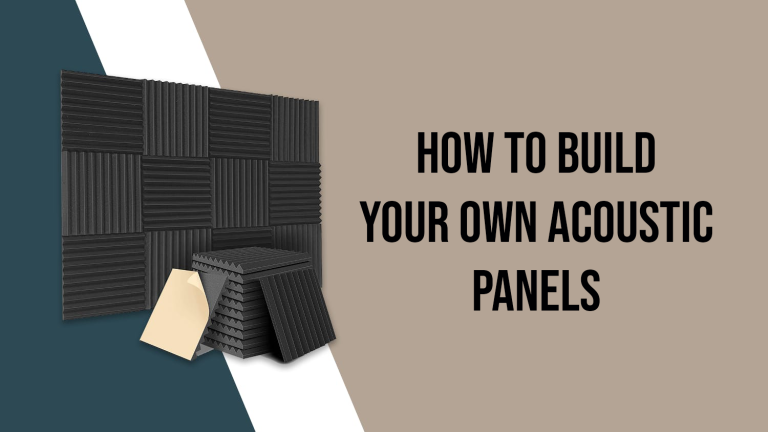How Many Acoustic Panels Do I Need?
The best singer can sound terrible, and the most delightful movie can sound bad due to echoes, reverb, flap, pressure waves, and echo.
The most excellent technique to reduce sound reflections and enhance sound quality is through acoustic panels.
You might want to think about adding acoustic panels if that sounds like your home studio or theater. So, the crucial question is: “How many acoustic panels do I need?”
How Many Acoustic Panels Do I Need?
The amount of panels required depends on the room’s dimensions, shape, and intended use. 20 % to 40% of the wall and ceiling surface is covered by low coverage, 60% or more by medium range, and more by high treatment. Start slowly and increase the volume till it sounds right because some home recording studios could require 80% or more.
While the quantity of panels you want varies depending on your area’s uses, an excellent place to start is with 10- 12 panels. However, for purposes requiring more sound control, that number can increase to 25–30 meetings.

Factors To Consider When Determining The Number Of Acoustic Panel
Since room acoustic panels cannot be generalized, this question cannot have a firm answer. Each room is unique. Thus each one would require specific acoustic treatment. There are also other factors to keep in mind.
Area Size
Sound waves travel more quickly between the sound source, reflection spots, and the listener or monitor in small spaces.
This causes a meniscal temporal delay between receiving direct and reflected sound waves, resulting in muddy, murky, or garbled sound that is challenging to perceive.
As our brain analyzes the reflected sound to determine proximity, it can also cause one to feel uneasy or enclosed.
High ceilings and parallel walls can also cause reverberation and echo because they force sound waves to travel farther between direct and reflected waves in large and long spaces.
To dissipate the reflected sound waves and enhance the listening experience, use absorbent panels and diffusers where the reflections occur.
Voices or musical instruments
The goal of total sound control while recording or otherwise attempting to regulate the sound quality entering a microphone is to capture as many surfaces in the space as you can.
This is valid for recording music audio and maintaining voice quality when making podcasts, for example.
The dialogue changes slightly when trying to regulate the noise of huge crowds.
Instead of needing acoustic panel penetration to maintain sound quality, you now need something to silence the din of many people talking.
System of speakers
Specific acoustic panel standards apply to speaker systems. In reality, in particular, acoustic panels’ significance for home theater systems is covered in a different post on our website.
The requirements for maintaining a speaker system can be challenging because they vary greatly depending on how many speakers are present.
Since each speaker has a clear reflection point, it is simple to understand how the number of speakers determines the required least number of acoustic panels.
However, sound disperses as it travels, which is why two panels are behind the single front-firing speaker in the previous illustration.
The predicted distribution of the sound and the number of reflection sites, thus, determine the lowest number, whereas the distinctive characteristics of the space determine the maximum number.
Surface Resources
Hard surfaces like stone, hardwood and drywall reflect or deflect sound waves, making sounds reverberate more intensely and for a longer time.
The reverberation duration is shortened, and the noise is dissipated by the absorption of sound waves by soft surfaces like carpets and plush furnishings.
The less maintenance needed, the more soft furnishings there are in the space.
Reflecting Points
The locations where sound from the speakers initially reflects off the walls, floor, or ceiling are significant factors.
The sound is muddied as a result of reflections before reaching the ears of the listeners. Start with the side walls; addressing the mirrored points on both sides reduces the reflected noise and might be sufficient for your needs.
Before moving on to the corners, the behind and front walls, as well as the ceiling, are first.
What Sort of Balance Should I Be Seeking With Acoustic Wall Panels?
Balance refers to how acoustic panels are distributed around a workplace. Covering one area with panels is OK, but if you leave another area completely naked, problems will still exist.
To lower the overall reverberation levels, it is best to have an even balance throughout the office. This can be achieved, as previously noted, by balancing the use of acoustic wall panels, hanging ceiling panels, and acoustic partition screens.
This type of layout has numerous surfaces that contain acoustic foam. This aids in reducing background noise at its source and halting its spread across the office.
Do Acoustic Panels Have a Limit?
Acoustic panels enhance a room’s acoustics by absorbing, diffusing, or trapping sound waves. Diffusers help keep the sound alive by dispersing it while absorbers slow down sound travel. However, too much absorption can result in a room that sounds empty. Both the ambiance and sounds are off.
For home theaters, it is not advised to use acoustic treatment on the walls, ceiling, or floor. However, it might be advantageous for a home studio when the goal is to produce clear, crisp sound rather than picking up reverb, echo, and other unwanted noises.
The kind, quantity, and location of the treatment depend on the use of the space and your goals for the acoustic panels.
FAQs (Frequently Ask Questions)
- How many acoustic panels do you need?
In actuality, we advise a 15% to 20% wall coverage as a general guideline. This may consist of hanging ceiling panels, acoustic wall panels, or a combination of several other acoustic solutions.
- How far apart should acoustic panels be?
All four panels must be arranged so that their long sides contact in order for the minimum perimeter of 48′ to be achieved. The circumference of the complete set of panels is increased to 72′ by spreading them out with four ′ gaps between each panel, which also boosts the layout’s efficiency by 50%.
- Will a few acoustic panels make a difference?
I need to know how many acoustic panels, therefore here is an image
But acoustic panels can have a significant impact. By minimizing the number of sound waves bouncing off the walls, acoustic panels enhance the sound of your current speakers. As long as they are strategically positioned, they can be very powerful, even with a small number of panels.
- Can you have too many acoustic panels?
The sound may be muffled if there are insufficient acoustic panels installed since they will absorb too many echoes and reverberations. This is not recommended for rooms like office spaces or theaters because some people may find the environment loud.
- Where should I place my acoustic panels?
Put acoustic panels where sound waves initially tend to impact the wall before reaching the listener’s ears. Place 3 to 6 feet up from the ground in situations where people standing or sitting in small spaces make a lot of noise.
Related Articles
How Do Acoustic Wall Panels Work
Can You Paint Acoustic Wall Panel
How To Make An Acoustic Wall Panel








